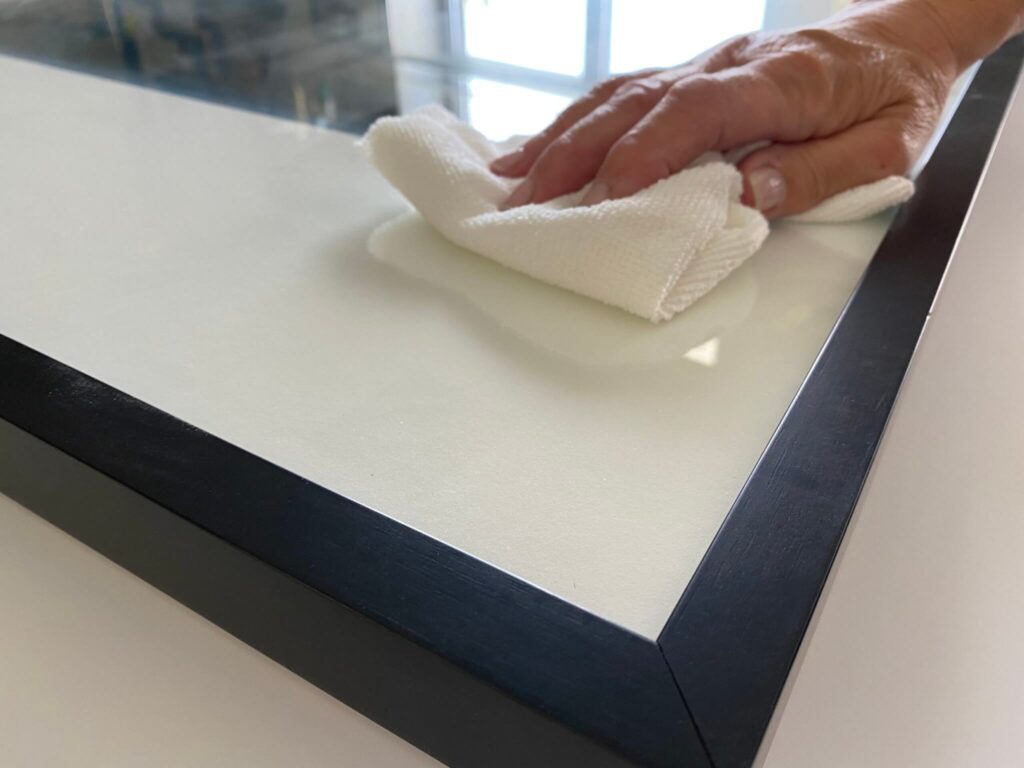While fine art glazing is designed to preserve and protect, it should also be cleaned and handled with care.
The following are recommendations based on the type of Tru Vue UV filtering glazing that we regularly frame and protect our client’s work with. If you have questions on what was used on your piece, please contact us, we want to ensure that the glazing continues to look as good as the artwork it protects!
Acrylic
Conservation Clear Acrylic
Materials:
Acrylic Cleaner
Clean microfiber cloth/lint-free cotton cloth
Directions:
With a damp microfiber cloth, apply light pressure and clean the surface.
Dry by blotting with a clean, slightly damp cloth.
- Never spray cleaner directly onto the surface, as it could damage the frame finish, as well as seep into the frame package.
- Never use paper towels or other paper-based products as they will scratch and abrade the surface.
- Never use any cleaning agents with ammonia.
Conservation Reflection Control Acrylic
Materials:
Mild soap and water solution
Clean microfiber cloth/lint-free cotton cloth
Directions:
Attempt to selectively spot clean using a dry microfiber cloth by wiping in a light, circular motion.
If dry cleaning is not effective, use a microfiber cloth with a mild soap and water solution.
Dry by blotting with a clean, slightly damp cloth.
- Never spray cleaner directly onto the surface, as it could damage the frame finish, as well as seep into the frame package.
- Never use paper towels or other paper based products as they will scratch and abrade the surface.
- Never use any cleaning agents with ammonia.
- Never use acrylic cleaners or polishing agents
Optium Museum Acrylic
Materials:
Ammonia Free Glass Cleaner
Clean microfiber cloth/lint-free cotton cloth
Directions:
Spray a small amount of ammonia-free glass cleaner onto a clean microfiber cloth and wipe in a circular motion on the glazing.
Wipe the surface dry with a dry section of the cloth to address any resultant wipe marks.
- Never spray cleaner directly onto the surface, as it could damage the frame finish, as well as seep into the frame package.
- Never use paper towels or other paper based products as they will scratch and abrade the surface.
- Never use any cleaning agents with ammonia.
- Never use acrylic cleaners or polishing agents on Optium glazing.
Glass
Conservation Clear Glass
Materials:
Ammonia Free Glass Cleaner
Clean microfiber cloth/lint-free cotton cloth
Directions:
Spray a small amount of ammonia-free glass cleaner onto a clean microfiber cloth and wipe in a circular motion on the glazing.
Wipe the surface dry with a dry section of the cloth to address any resultant wipe marks.
- Never spray cleaner directly onto the surface, as it could damage the frame finish, as well as seep into the frame package.
Conservation Reflection Control Glass
Materials:
Ammonia Free Glass Cleaner
Clean microfiber cloth/lint-free cotton cloth
Directions:
Spray a small amount of ammonia-free glass cleaner onto a clean microfiber cloth and wipe in a circular motion on the glazing.
Wipe the surface dry with a dry section of the cloth to address any resultant wipe marks.
- Never spray cleaner directly onto the surface, as it could damage the frame finish, as well as seep into the frame package.
Museum Glass
Materials:
Ammonia Free Glass Cleaner
Clean microfiber cloth/lint-free cotton cloth
Directions:
Spray a small amount of ammonia-free glass cleaner onto a clean microfiber cloth and wipe in a circular motion on the glazing.
Wipe the surface dry with a dry section of the cloth to address any resultant wipe marks.
- Never spray cleaner directly onto the surface, as it could damage the frame finish, as well as seep into the frame package.
Questions?
Are you unsure about what kind of glazing you have? Are you concerned about the condition of your piece?
Does your piece need further intervention or care?
Contact us at:
(847) 234-1982

